What Is Audience Analysis?
Audience analysis is the process of collecting, interpreting, and understanding information related to your target audience. The main goal is to establish who your audience is. Their needs, preferences, and behaviors. And how they engage with your brand or industry.
A target audience analysis helps you answer questions like:
- Who makes up my core audience?
- How do they perceive my brand, and what are their expectations?
- What challenges or needs do they have that my product or service can address?
- Through which channels and types of content can I most effectively reach and engage them?
Audience analysis is more than just gathering data. It's about diving deep into the motivations and factors driving your audience's behaviors. So you understand who your customers are. And what they care about.
Why Is Audience Analysis Important?
Understanding your audience is the cornerstone of any successful business or marketing strategy. It's crucial because it:
- Helps align business decisions and marketing strategies with customer expectations and needs
- Enables you to segment your audience into groups, so you can personalize communication and offers
- Guides you in determining which marketing channels are most effective for reaching your audience, so you can allocate your ad budget effectively
- Offers insights into how you can refine your products or services to meet the needs of your audience
- Enables you to show customers you understand and care about their needs, which builds stronger relationships and fosters loyalty

Let’s consider an audience analysis example.
Imagine you’re a small business specializing in eco-friendly outdoor gear.
You examine sales data from the last six months. Your main shoppers are environmentally conscious consumers aged 25-40 who partake in outdoor activities.
Next, you conduct audience research like surveys, focus groups, and social media analytics. You realize that this group values sustainability, prefers products made from recycled materials, and seeks brands that contribute to conservation efforts.
With this insight, you tailor your marketing messages to highlight your brand's commitment to the environment. Showcasing your products' sustainable features and aligning your campaigns with conservation initiatives helps drive sales and customer loyalty.
Types of Audience Analysis
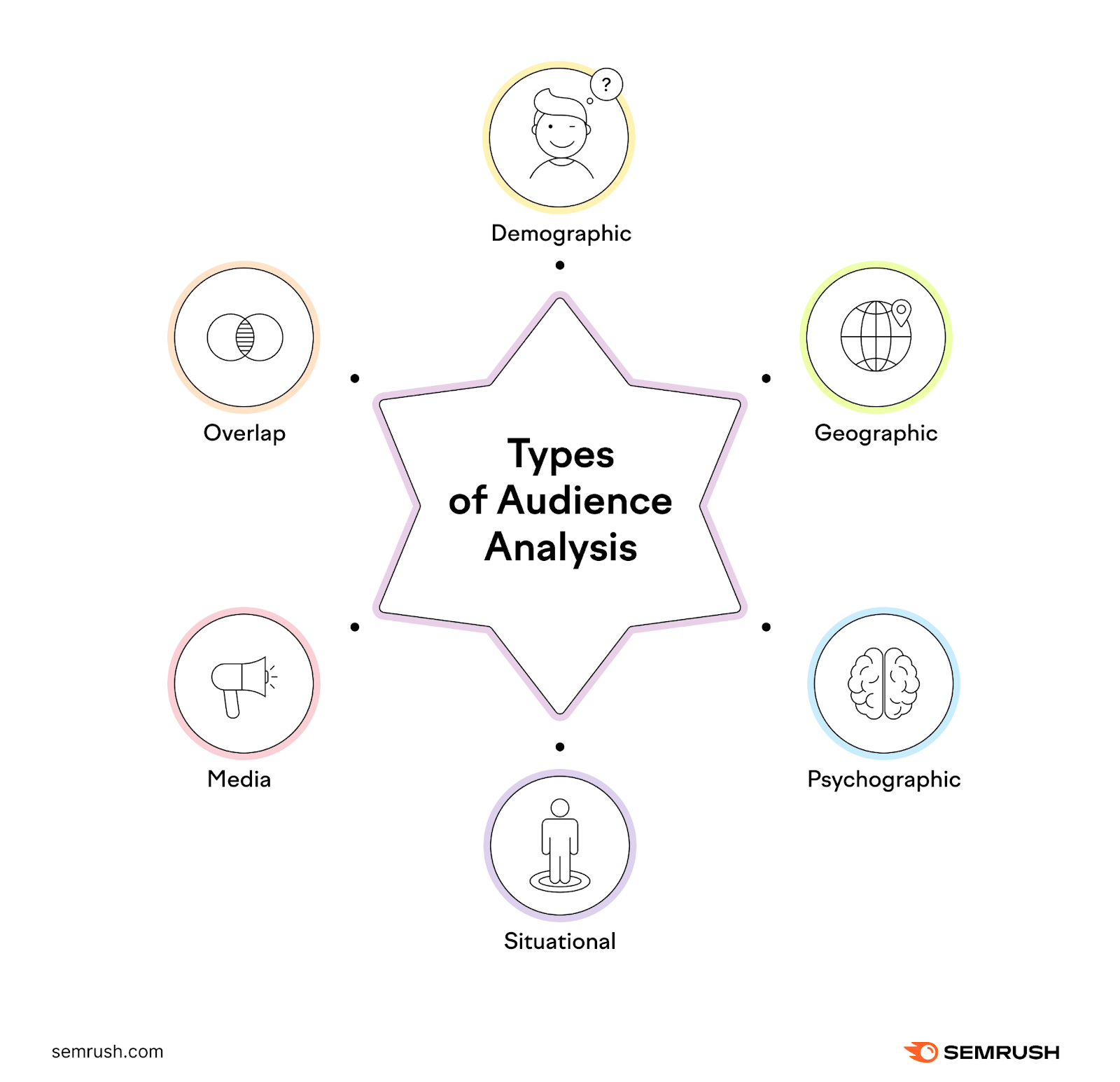
You can approach audience analysis from various angles. Each provides unique insights into your customers. Here’s a breakdown of the different types of audience analysis and what each one entails:
Demographic Audience Analysis
Demographic analysis focuses on quantifiable characteristics of your audience such as age and gender. This information is useful for segmenting your customers into easily distinguishable groups. So you can adapt your communication and offerings to suit their needs.
Geographic Audience Analysis
Geographic analysis examines the physical location of your audience. This includes broad regions like countries and states, as well as cities and neighborhoods. It helps you decide which markets to focus on and expand into. And helps you tailor your products and messaging to local cultures, languages, and needs.
Psychographic Audience Analysis
Psychographic analysis delves deeper into the attitudes, interests, personalities, values, and lifestyles of your audience. When you understand what drives their behaviors and decisions, you can develop more nuanced marketing strategies that resonate on an emotional level. This leads to stronger brand affinity and loyalty.
Situational Audience Analysis
In traditional settings, like giving a speech, situational analysis of an audience considers factors such as the audience’s size, their attitude toward the speaker, their prior knowledge of the topic, and the occasion.
In the business world, situational analysis looks at the size of your targeted audience, their perception of your brand and its products, their existing knowledge about what you offer, and the specific online platforms—such as websites or social media channels—where they encounter your ads or engage with your content and products.
Media Audience Analysis
Media analysis focuses on understanding where your audience prefers to consume information. And the types of content and influencers they pay attention to. Knowing your audience's media preferences allows you to optimize your partnerships and marketing spend.
A good way to do this is with the Audience Intelligence App from Semrush.
For example, in this report for Lululemon, we can see that the top content sources are Oprah Winfrey, Vogue, and The New York Times. Lululemon’s audience is most likely to be influenced by Ellen DeGeneres, Kim Kardashian, and Oprah Winfrey.

Competitor Audience Overlap Analysis
Overlap analysis involves examining your competitors' audiences to identify overlaps and opportunities. By understanding who is engaging with competing brands, you can pinpoint gaps in the market, areas for improvement, and potential audiences that may be underserved.
This type of analysis is crucial for positioning your brand effectively and identifying unique value propositions that set you apart from the competition.
To run an audience analysis with Semrush, open the Market Explorer Tool. Type in the domains of three competitors, and click “Create and analyze.”

You’ll see a summary of your audience and their main characteristics, including age, gender, employment status, and education level. So you can collect some basic data and gain a fundamental understanding of what they're like.
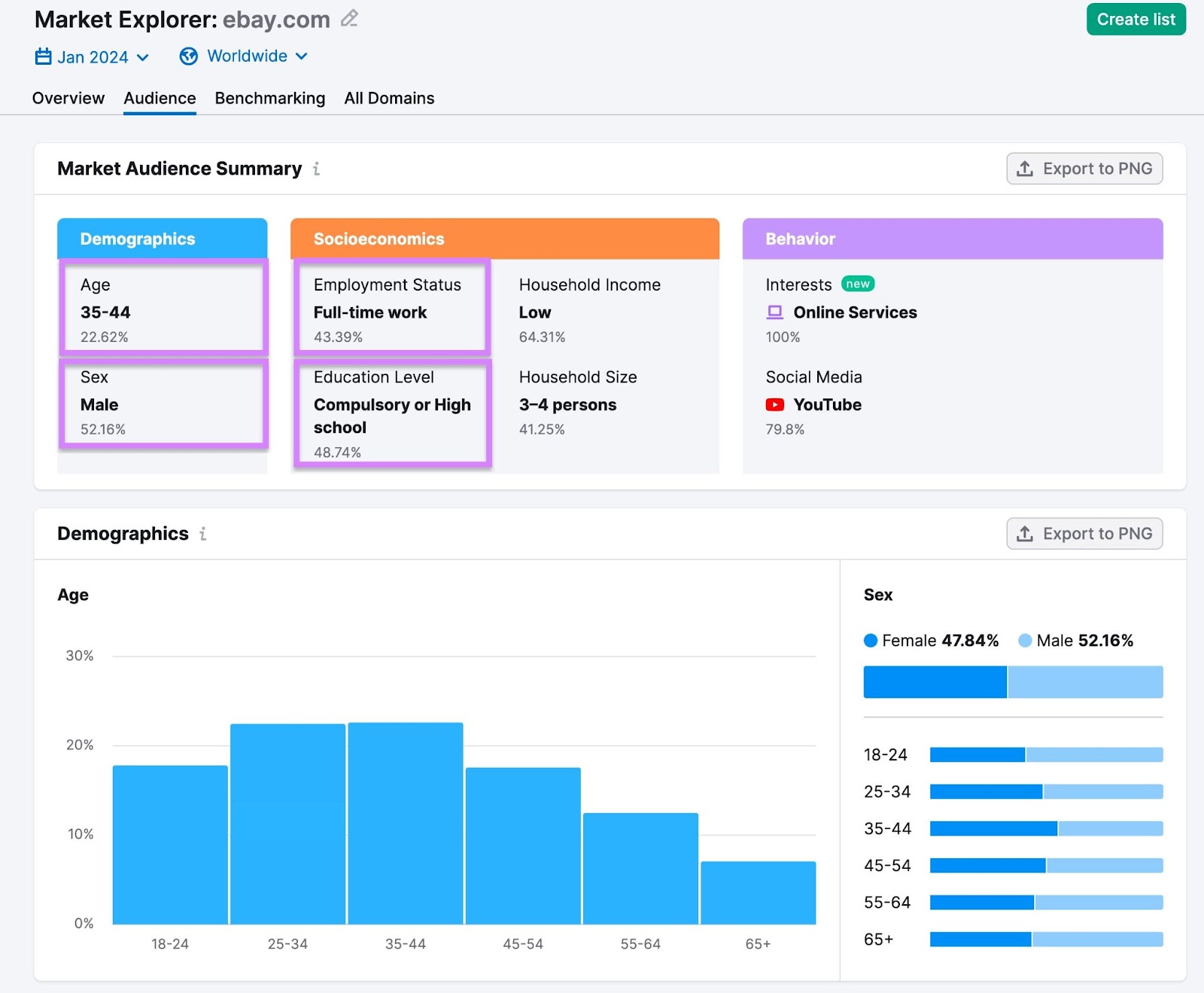
Scroll down to discover their interests and preferred social media channels. So you know what makes them tick, and where you can best engage with them.
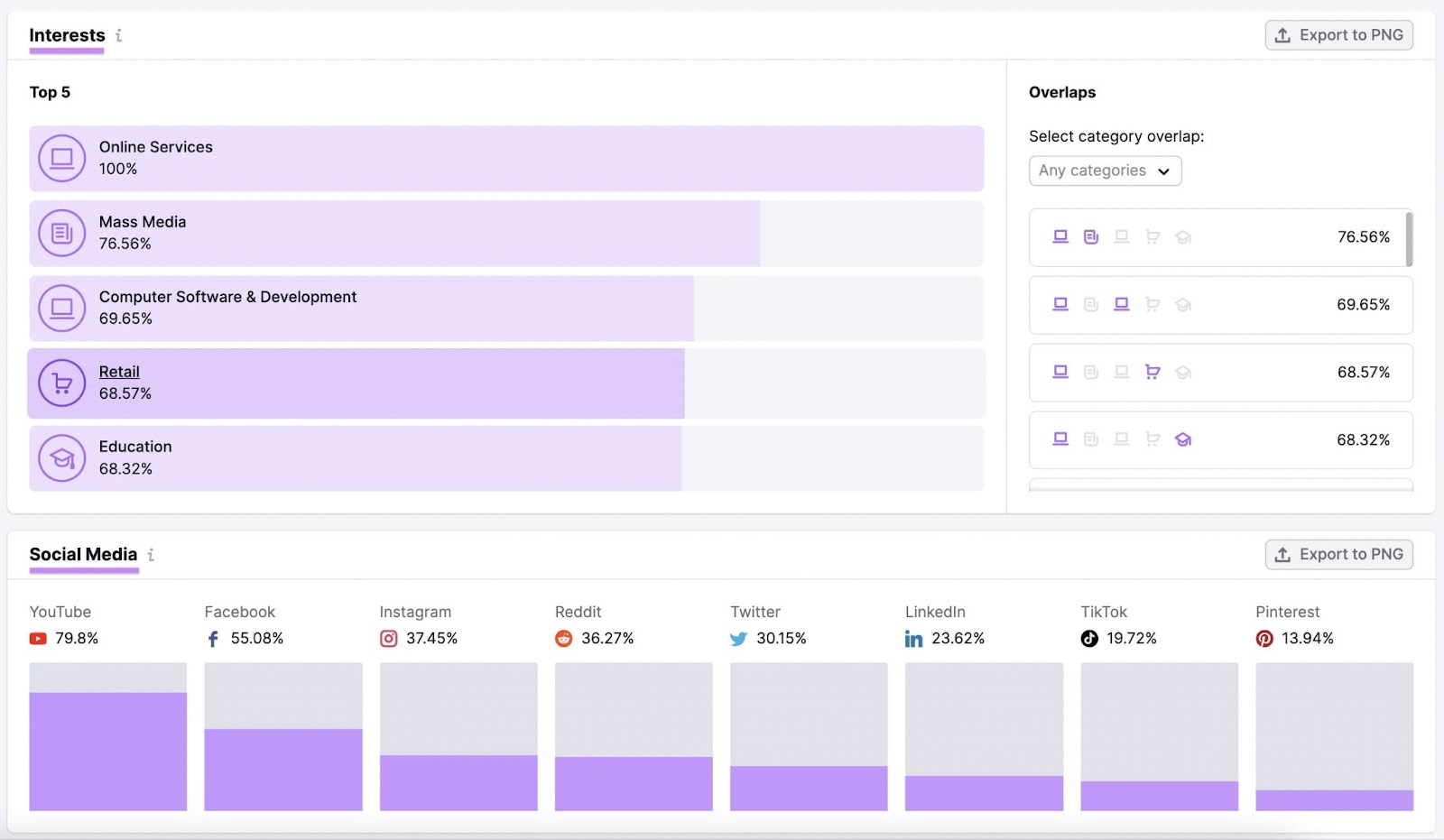
How to Perform Audience Analysis

So, you’d like to learn more about your potential customers' needs and interests. Your exact approach will depend on the data and tools you have available. Here's how to go about it:
1. Analyze Your Current Customers
The first step is to figure out who your audience is. Your company's database or customer relationship management (CRM) system is the perfect place to begin.
These platforms are packed with info that can clue you in on who's buying from you, what they think about your products, and how they prefer to interact with your brand.
For example, take a look at the customers who have purchased from you over the past 6-12 months. Do you spot any trends? Pay special attention to who is buying what, and when. And don’t forget to check returns and customer service data.
2. Analyze Your Website Visitors
Website data can reveal a lot about your customers. After all, it’s the main touchpoint between your brand and the consumer. Use Google Analytics or your web analytics tool of choice to find out:
- How your site visitors found you
- The typical customer journey (where users enter and leave your site)
- Which product pages and blog articles are most popular
- What videos your users watch
- Where they drop off
This enables you to gain a better understanding of their habits, interests, and behaviors.
3. Check Social Media
Social media is a goldmine for audience insights. It's where customers freely express their opinions, preferences, and feedback about brands.
Use Semrush’s Media Monitoring app to see what customers are saying about your brand. Just type in your brand name to run a report. You’ll see the number of mentions (positive and negative), and can track how this has changed over time:

You also have the option to dive into specific conversations and pinpoint exactly what customers have said about you. Like in this example report for Netflix:
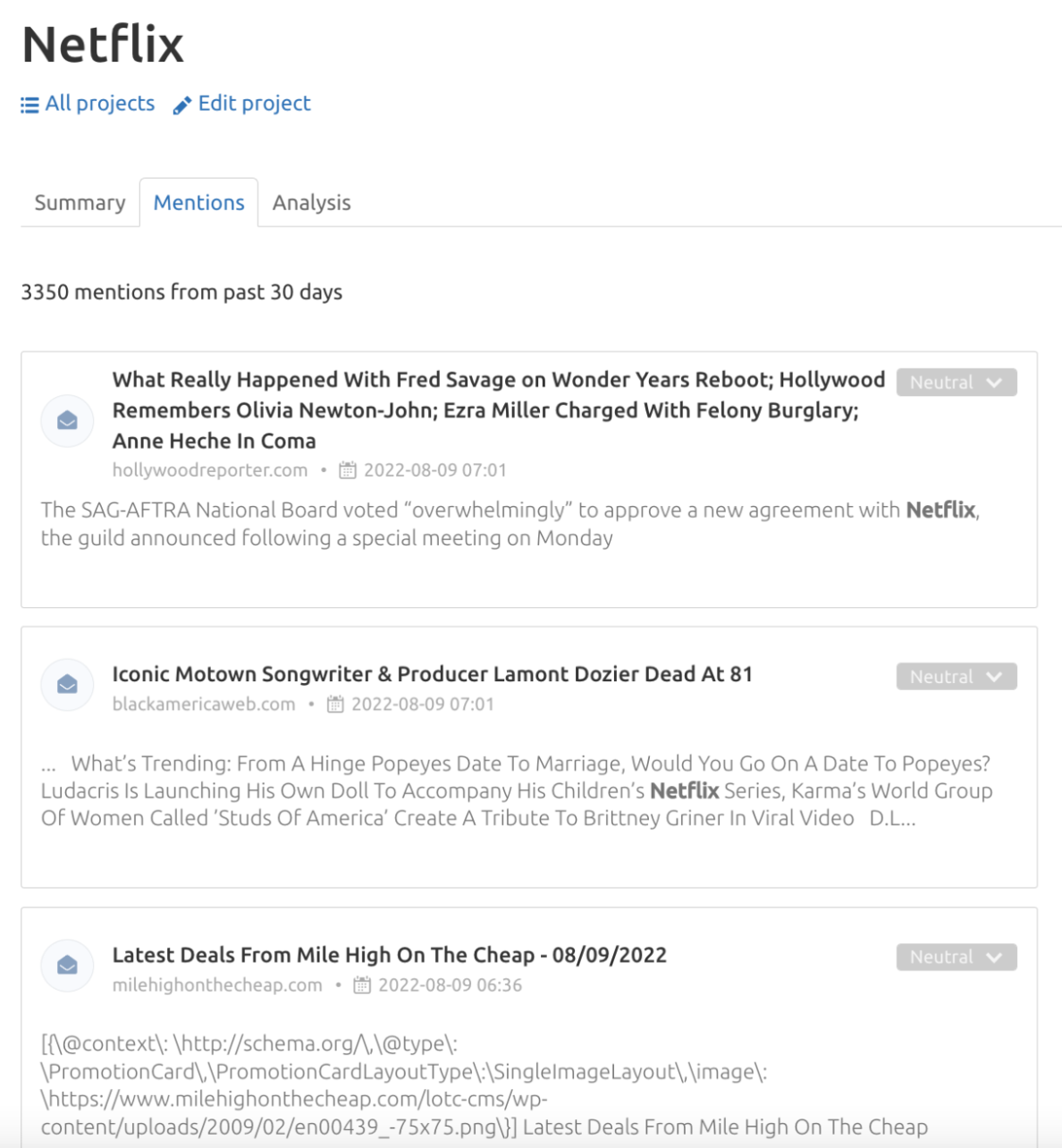
A social media audience analysis helps you understand how your audience perceives your brand. So you can flag areas for improvement and expand on what you're doing right.
4. Leverage Audience Analysis Tools
Audience analysis tools can help you understand your audience on a deeper level. It speeds up the process of identifying your target audience. And provides insights into the demographics, socioeconomics, and behavior of a brand’s customers.
Use the One2Target tool from Semrush to gain deep insights into your target audience.To get started, enter the URL of at least one of your competitors. And hit “Analyze.”

At the top, you’ll see how the audience is distributed across age and gender. You'll also gain insight into the number of web visitors. And where they come from.
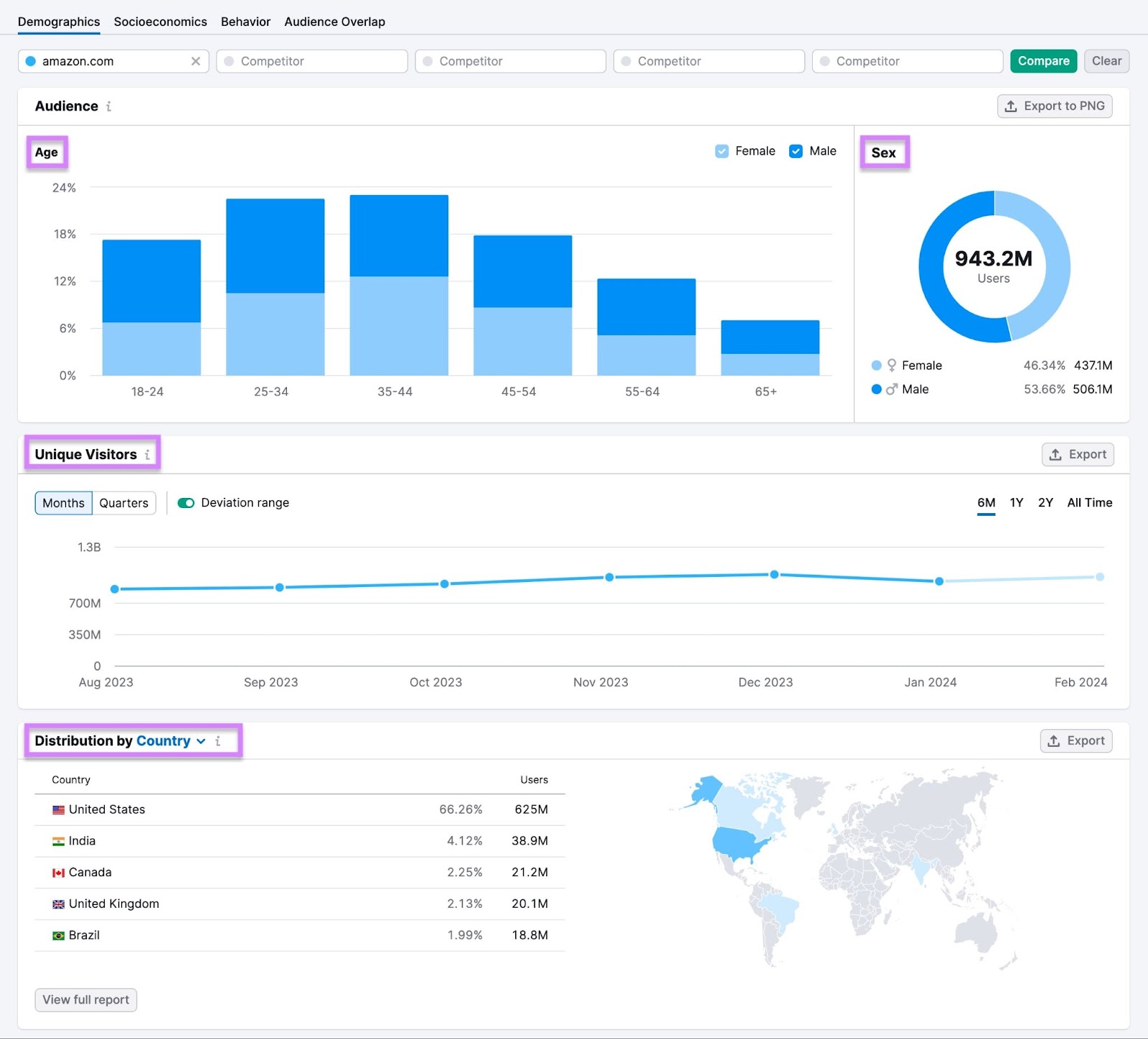
This will help you tailor your marketing messaging to resonate with the demographics of your audience. For example, a younger audience might prefer a more casual tone of voice, or “cooler” branding.
Next, open the “Socioeconomics” tab to learn more about your audience’s household size and income level.

And their employment status and education level:
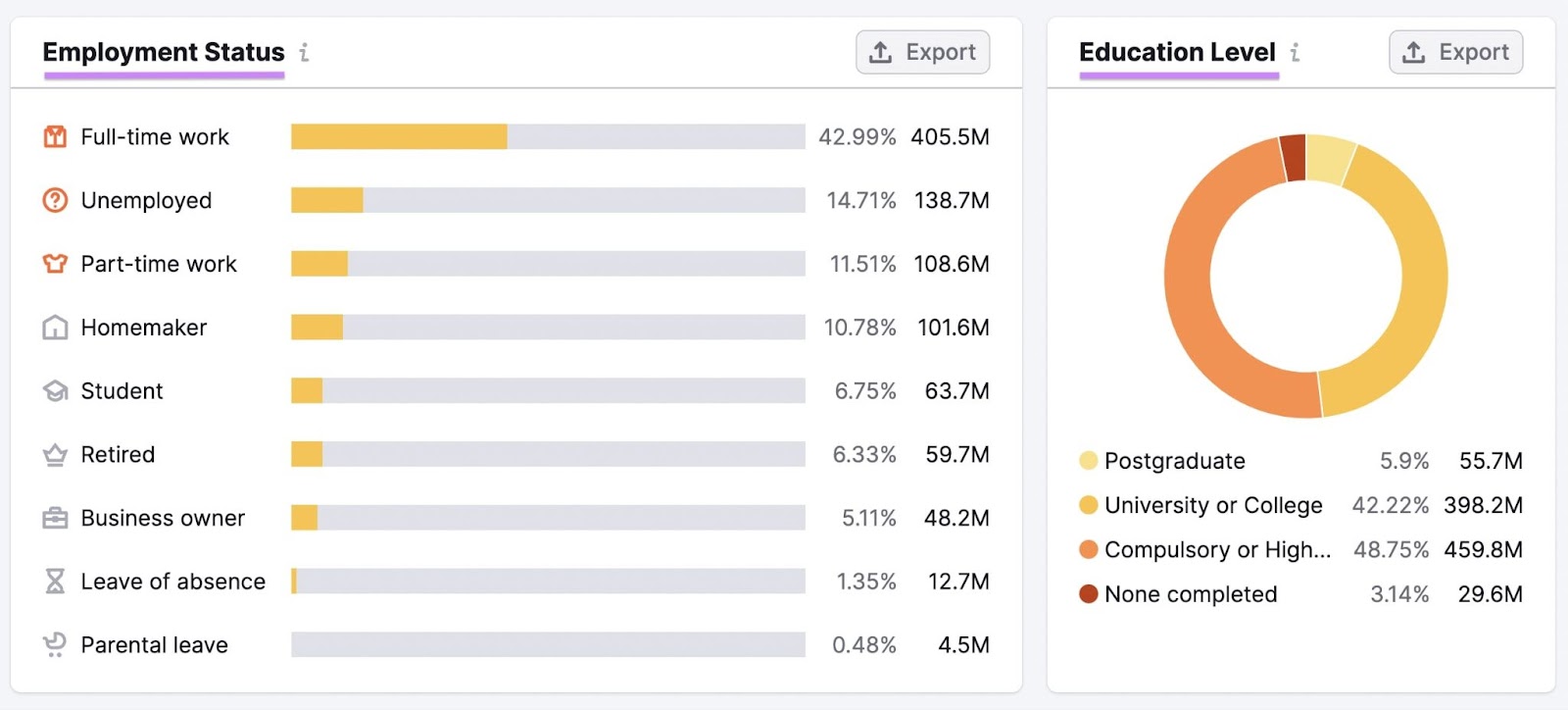
These insights can help you set your pricing strategy. If your audience is price-sensitive, you might consider running special offers and discounts. A high-income audience is more likely to be interested in top-quality, luxury items.
Next, navigate to the "Behavior" tab. This tells you more about how and where your audience engages online.
You'll see the types of websites they visit. And whether your audience prefers browsing on desktop or mobile.

Scroll down to see a breakdown of the social media channels your audience uses.

This insight will help you decide where to focus your marketing efforts. So you invest your time and budget on the channels most likely to have an impact.
5. Engage with Your Customers
You can spend hours researching online. But to truly understand your audience, you’ll need to go out there and actually engage with customers.
Data and analytics give you part of the picture. You can enrich this information with qualitative insights that give you more nuanced information. Do this via:
- Market research
- Surveys
- Interviews
- Focus groups
Insights from qualitative research can help you uncover people’s motivations, challenges, and attitudes. They enable you to connect with your audience on a deeper level. And ask follow-up questions if needed. So you can dive deeper into how, when, and why they buy from you. And how they perceive your brand compared to competitors'.
Be sure to record your findings. List the main insights, as well as the stats. So you can share the info with others later.
6. Segment Your Audience
Segmentation is the process of breaking down your audience into groups. This is important because a one-size-fits-all approach is likely to be too simplistic. Especially if your brand sells to different types of customers.
For example, if you’re an apparel brand, you might cater to men, women, teenagers, and children.
Through segmentation, you can identify and cater to the specific needs and preferences of different groups.
There are many ways to segment your audience. Here are a few examples:
- Demographic Segmentation: This involves categorizing your audience based on attributes like age (like teenagers or retirees), gender, and location (such as urban and rural residents).
- Socioeconomic Segmentation: Groups are based on economic and social status, such as household income (low-income families vs. high earners) and employment status (such as students and young professionals).
- Psychographic Segmentation: This breaks down your audience based on their interests, values, and lifestyles. It delves deeper into what motivates your audience, their hobbies, and their preferences. For example, you might target environmentally conscious consumers or fitness enthusiasts.
Splitting your audience into segments allows you to better understand the nuances and how to meet their needs. So you can ensure your business strategy and marketing efforts are effective.
7. Create Buyer Personas
Buyer personas are semi-fictional representations of your audience based on data and research. They help you understand your customers (and prospective customers) better. So you can tailor your content, messaging, product development, and services to meet the specific needs, behaviors, and concerns of different groups.
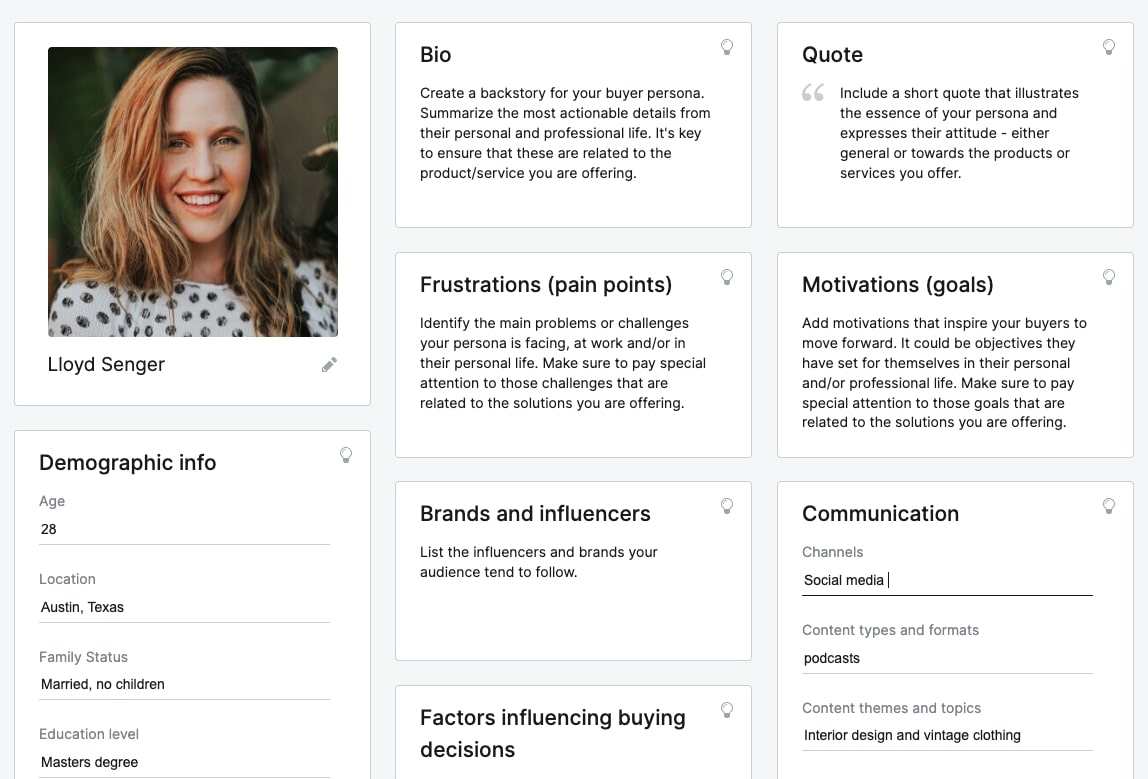
A comprehensive buyer persona includes:
Demographic Information
- Age
- Location
- Gender identity
- Family status
- Education level
- Income level
This information is typically more relevant to Business-to-Consumer (B2C). It provides a snapshot of who the customer is from a personal and social standpoint.
Professional Information
- Job title
- Job responsibilities
- Reporting structure (who they report to and who reports to them)
- Company details (size, revenue, etc.)
This information is more relevant to B2B. It offers insight into the professional life and environment of the potential buyer.
Additional Insights
- Frustrations and pain points
- Factors influencing buying decisions
- Expectations from your product/service
- Preferred communication channels
- Preferred content types and formats
- Known/preferred brands and influencers
Deep Dives
- Jobs to be Done: The task your buyer wants to accomplish with your product or service
- Feedback: Identifies areas for improvement for your product or service
- Purchase Triggers and Barriers: What prompts them to buy and what holds them back?
- Comparison Criteria: How they evaluate you against competitors
8. Share Audience Analysis Insights Across Your Organization
If only a few people in your organization are aware of your audience insights, you're not getting the full value out of them. These insights should be widely shared. And integrated into the wider business strategy.
Encourage collaboration and input from all strategic and customer-facing teams during the data collection and persona creation processes. Once the analysis is complete, consider organizing a company-wide meeting. Or department-specific workshops to go through the key findings.
Be sure to explain how audience insights can impact each team's responsibilities. For example:
- Sales teams can customize their approach based on customer priorities, leading to more meaningful conversations, and ultimately, sales
- Marketing teams can refine content strategies and distribution plans to better align with audience preferences
- Product development can use audience insights to guide feature enhancements and new product development
9. Stay Updated
Remember, the environment in which your customers operate is always evolving. Changes in communication platform preferences, trends, and values mean your audience analysis and personas need to be dynamic.
Regularly collect audience data and customer feedback so your strategies, messaging, and products remain fresh and relevant. Staying ahead of these changes enables your business to keep meeting customers’ needs as they change.
Get Started with Audience Analysis
Audience analysis is one of the most important things to do for your brand. When done right, it can help you improve every aspect of your business, from marketing messaging to product strategy. This all has a positive impact on customer loyalty and retention.
Ready to get started? Gain valuable audience insights with Semrush's .Trends. This suite of tools includes everything you need to run a powerful audience analysis, including Market Explorer and One2Target. In order to:
- Discover the key demographics of your target audience
- Identify the best channels and tactics to reach your audience
- Get insights into your competitors’ audiences
And more.
Sign up for a free trial of Semrush now to understand your audience on a whole new level.
